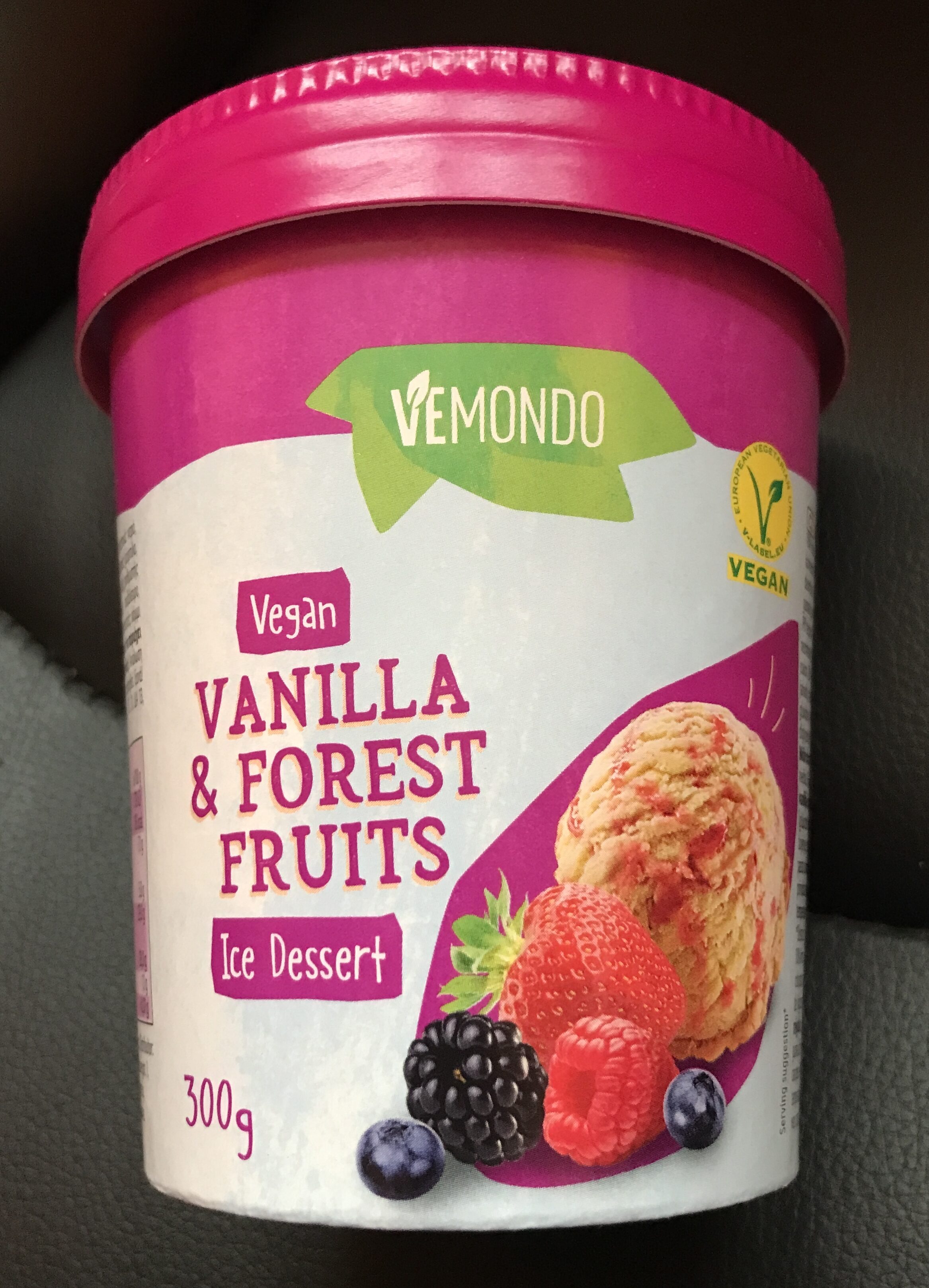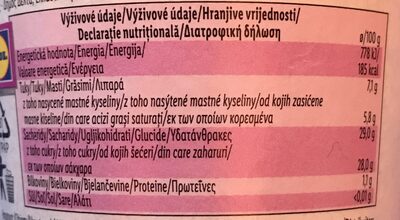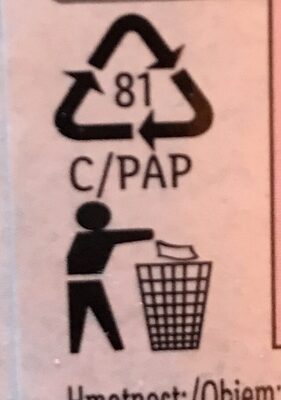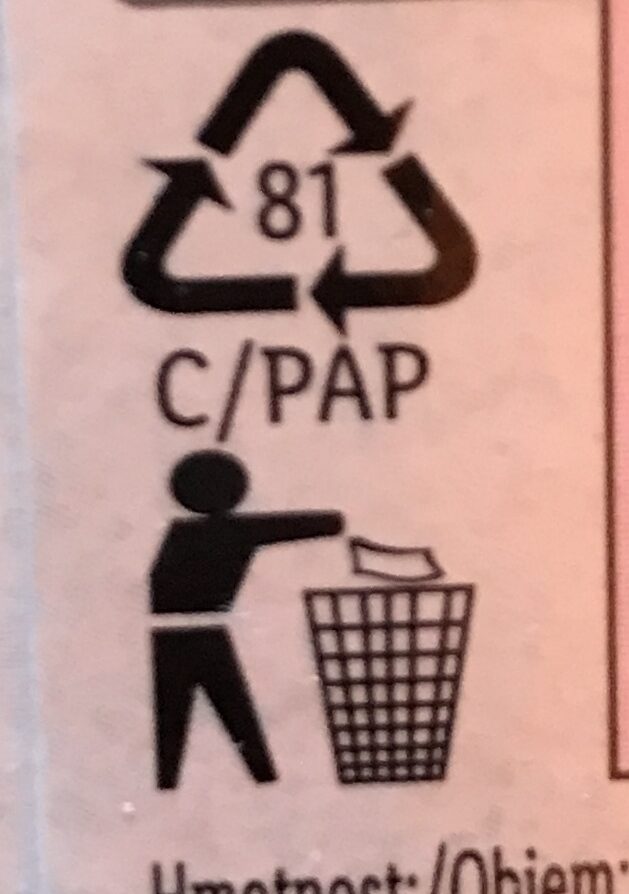Ajuda'ns a fer que la transparència alimentària sigui la norma!
Com a organització sense ànim de lucre, depenem de les vostres donacions per continuar informant els consumidors de tot el món sobre tot allò què mengen.
La revolució alimentària comença amb tu!
Zmrzlina vanilka s lesními plody - Vemondo - 300 g (500 ml)
Zmrzlina vanilka s lesními plody - Vemondo - 300 g (500 ml)
Codi de barres ambigu: aquest producte té un codi de barres amb número de circulació restringit per a productes d'una empresa. Això significa que diferents productors i botigues poden utilitzar el mateix codi de barres per a diferents productes.
×
Aquesta pàgina del producte no està completa. Podeu ajudar a completar-la editant-la i afegint-hi més dades a partir de les fotos ja disponibles, o fent-ne més amb l'aplicació de androide o iPhone / iPad. Gràcies!
×
Codi de barres: 20968526
Nom comú: Zmrzlina s rostlinným tukem s vanilkovou chutí se sirupem z lesního ovoce
Quantitat: 300 g (500 ml)
Empaquetament: Material compost, 81 C/X, 81 C/PAP, cs:Green dot
Marques: Vemondo
Categories: Aliments i begudes amb base vegetal, en:Dairy substitutes, Postres, Aliments congelats, Postres congelats, Sorbets i gelats, Gelat, en:Plant-based ice creams, en:Plant-based ice cream tubs
Etiquetes, certificacions, premis:
Vegetarià, Vegà, Unió Vegetariana Europea, Unió Vegana Vegetariana Europea, Fet a Itàlia

Llocs de fabricació o processament: Italy
Botigues: Lidl
Països on es va vendre: Croàcia, República Txeca, Romania, Eslovàquia, Espanya, Suècia
Matching with your preferences
Salut
Ingredients
-
33 ingredients
Txec: pitná voda, cukr, 10% sirup z lesního ovoce (glukózový sirup, cukr, pitná voda, 15% dřeň z lesního ovoce (borůvky, ostružiny, černý rybíz, jahody, maliny), koncentrát z černé mrkve, přírodní aroma, regulátor kyselosti: kyselina citronová; zahušťovadlo: pektiny), glukózový sirup, kokosový olej, dextróza, rýžová mouka, mandlová pasta, hrachová bílkovina, emulgátor: mono - a diglyceridy mastných kyselin, stabilizátory: karubin, guma guar, přírodní aroma, 0,08% vanilkové lusky, barvivo: karoteny.Al·lèrgens: en:Nuts, cs:mandlová-pasta, cs:mandlová-pastaRastres: en:Nuts, en:Peanuts, en:Soybeans
Processament d'aliments
-
Aliments ultra processats
Elements que indiquen que el producte està al grup 4 - Aliments i begudes ultraprocessats:
- Additiu: E160a - Carotè
- Additiu: E410 - Goma de garrofí
- Additiu: E412 - Goma de guar
- Additiu: E440 - Pectina
- Additiu: E471 - Monoglicèrids i diglicèrids d'àcids grassos
- Ingredient: Color
- Ingredient: Dextrosa
- Ingredient: Emulsionant
- Ingredient: Aromes
- Ingredient: Glucosa
- Ingredient: Xarop de glucosa
- Ingredient: Espessidor
Els productes alimentaris es classifiquen en 4 grups segons el seu grau de processament:
- Aliments no processats o mínimament processats
- Ingredients culinaris processats
- Aliments processats
- Aliments ultra processats
La determinació del grup es fa en funció de la categoria del producte i dels ingredients que conté.
Additius
-
E160a - Carotè
Carotene: The term carotene -also carotin, from the Latin carota, "carrot"- is used for many related unsaturated hydrocarbon substances having the formula C40Hx, which are synthesized by plants but in general cannot be made by animals -with the exception of some aphids and spider mites which acquired the synthesizing genes from fungi-. Carotenes are photosynthetic pigments important for photosynthesis. Carotenes contain no oxygen atoms. They absorb ultraviolet, violet, and blue light and scatter orange or red light, and -in low concentrations- yellow light. Carotenes are responsible for the orange colour of the carrot, for which this class of chemicals is named, and for the colours of many other fruits, vegetables and fungi -for example, sweet potatoes, chanterelle and orange cantaloupe melon-. Carotenes are also responsible for the orange -but not all of the yellow- colours in dry foliage. They also -in lower concentrations- impart the yellow coloration to milk-fat and butter. Omnivorous animal species which are relatively poor converters of coloured dietary carotenoids to colourless retinoids have yellowed-coloured body fat, as a result of the carotenoid retention from the vegetable portion of their diet. The typical yellow-coloured fat of humans and chickens is a result of fat storage of carotenes from their diets. Carotenes contribute to photosynthesis by transmitting the light energy they absorb to chlorophyll. They also protect plant tissues by helping to absorb the energy from singlet oxygen, an excited form of the oxygen molecule O2 which is formed during photosynthesis. β-Carotene is composed of two retinyl groups, and is broken down in the mucosa of the human small intestine by β-carotene 15‚15'-monooxygenase to retinal, a form of vitamin A. β-Carotene can be stored in the liver and body fat and converted to retinal as needed, thus making it a form of vitamin A for humans and some other mammals. The carotenes α-carotene and γ-carotene, due to their single retinyl group -β-ionone ring-, also have some vitamin A activity -though less than β-carotene-, as does the xanthophyll carotenoid β-cryptoxanthin. All other carotenoids, including lycopene, have no beta-ring and thus no vitamin A activity -although they may have antioxidant activity and thus biological activity in other ways-. Animal species differ greatly in their ability to convert retinyl -beta-ionone- containing carotenoids to retinals. Carnivores in general are poor converters of dietary ionone-containing carotenoids. Pure carnivores such as ferrets lack β-carotene 15‚15'-monooxygenase and cannot convert any carotenoids to retinals at all -resulting in carotenes not being a form of vitamin A for this species-; while cats can convert a trace of β-carotene to retinol, although the amount is totally insufficient for meeting their daily retinol needs.Origen: Wikipedia (Anglès)
-
E330 - Acid citric
Citric acid: Citric acid is a weak organic acid that has the chemical formula C6H8O7. It occurs naturally in citrus fruits. In biochemistry, it is an intermediate in the citric acid cycle, which occurs in the metabolism of all aerobic organisms. More than a million tons of citric acid are manufactured every year. It is used widely as an acidifier, as a flavoring and chelating agent.A citrate is a derivative of citric acid; that is, the salts, esters, and the polyatomic anion found in solution. An example of the former, a salt is trisodium citrate; an ester is triethyl citrate. When part of a salt, the formula of the citrate ion is written as C6H5O3−7 or C3H5O-COO-3−3.Origen: Wikipedia (Anglès)
-
E410 - Goma de garrofí
Locust bean gum: Locust bean gum -LBG, also known as carob gum, carob bean gum, carobin, E410- is a thickening agent and a gelling agent used in food technology.Origen: Wikipedia (Anglès)
-
E412 - Goma de guar
Guar gum: Guar gum, also called guaran, is a galactomannan polysaccharide extracted from guar beans that has thickening and stabilizing properties useful in the food, feed and industrial applications. The guar seeds are mechanically dehusked, hydrated, milled and screened according to application. It is typically produced as a free-flowing, off-white powder.Origen: Wikipedia (Anglès)
-
E440 - Pectina
Pectin: Pectin -from Ancient Greek: πηκτικός pēktikós, "congealed, curdled"- is a structural heteropolysaccharide contained in the primary cell walls of terrestrial plants. It was first isolated and described in 1825 by Henri Braconnot. It is produced commercially as a white to light brown powder, mainly extracted from citrus fruits, and is used in food as a gelling agent, particularly in jams and jellies. It is also used in dessert fillings, medicines, sweets, as a stabilizer in fruit juices and milk drinks, and as a source of dietary fiber.Origen: Wikipedia (Anglès)
-
E471 - Monoglicèrids i diglicèrids d'àcids grassos
Mono- and diglycerides of fatty acids: Mono- and diglycerides of fatty acids -E471- refers to a food additive composed of diglycerides and monoglycerides which is used as an emulsifier. This mixture is also sometimes referred to as partial glycerides.Origen: Wikipedia (Anglès)
Anàlisi dels ingredients
-
Pot contenir oli de palma
Ingredients que poden contenir oli de palma: E471, E160a
-
Vegà
No s'han detectat ingredients no vegans
Ingredients no reconeguts: cs:sirup-z-lesního-ovoce, cs:dřeň-z-lesního-ovoce, cs:borůvky, cs:ostružiny, cs:černý-rybíz, cs:jahody, cs:maliny, cs:koncentrát-z-černé-mrkve, cs:mandlová-pasta, cs:hrachová-bílkovina, cs:stabilizátory, cs:vanilkové-luskyAlguns ingredients no s'han pogut reconèixer.
Necessitem la teva ajuda!
Podeu ajudar-nos a reconèixer més ingredients i analitzar millor la llista d'ingredients d'aquest producte i d'altres mitjançant:
- Editeu aquesta pàgina de producte per corregir les faltes d’ortografia de la llista d’ingredients i/o per eliminar els ingredients d’altres idiomes i frases que no estiguin relacionades amb els ingredients.
- Afegiu entrades, sinònims o traduccions noves a les nostres llistes multilingües d’ingredients, mètodes de processament d’ingredients i etiquetes.
Uniu-vos al canal #ingredients del nostre espai de discussió a Slack i/o apreneu sobre l'anàlisi dels ingredients en la nostra wiki, si voleu ajudar. Gràcies!
-
Vegetarià
No s'han detectat ingredients no vegetarians
Ingredients no reconeguts: cs:sirup-z-lesního-ovoce, cs:dřeň-z-lesního-ovoce, cs:borůvky, cs:ostružiny, cs:černý-rybíz, cs:jahody, cs:maliny, cs:koncentrát-z-černé-mrkve, cs:mandlová-pasta, cs:hrachová-bílkovina, cs:stabilizátory, cs:vanilkové-luskyAlguns ingredients no s'han pogut reconèixer.
Necessitem la teva ajuda!
Podeu ajudar-nos a reconèixer més ingredients i analitzar millor la llista d'ingredients d'aquest producte i d'altres mitjançant:
- Editeu aquesta pàgina de producte per corregir les faltes d’ortografia de la llista d’ingredients i/o per eliminar els ingredients d’altres idiomes i frases que no estiguin relacionades amb els ingredients.
- Afegiu entrades, sinònims o traduccions noves a les nostres llistes multilingües d’ingredients, mètodes de processament d’ingredients i etiquetes.
Uniu-vos al canal #ingredients del nostre espai de discussió a Slack i/o apreneu sobre l'anàlisi dels ingredients en la nostra wiki, si voleu ajudar. Gràcies!
-
Detalls de l'anàlisi dels ingredients
Necessitem la teva ajuda!
Alguns ingredients no s'han pogut reconèixer.
Necessitem la teva ajuda!
Podeu ajudar-nos a reconèixer més ingredients i analitzar millor la llista d'ingredients d'aquest producte i d'altres mitjançant:
- Editeu aquesta pàgina de producte per corregir les faltes d’ortografia de la llista d’ingredients i/o per eliminar els ingredients d’altres idiomes i frases que no estiguin relacionades amb els ingredients.
- Afegiu entrades, sinònims o traduccions noves a les nostres llistes multilingües d’ingredients, mètodes de processament d’ingredients i etiquetes.
Uniu-vos al canal #ingredients del nostre espai de discussió a Slack i/o apreneu sobre l'anàlisi dels ingredients en la nostra wiki, si voleu ajudar. Gràcies!
cs: pitná voda, cukr, sirup z lesního ovoce 10% (glukózový sirup, cukr, pitná voda, dřeň z lesního ovoce 1.5% (borůvky, ostružiny, černý rybíz, jahody, maliny), koncentrát z černé mrkve, přírodní aroma, regulátor kyselosti (kyselina citronová), zahušťovadlo (pektiny)), glukózový sirup, kokosový olej, dextróza, rýžová mouka, _mandlová pasta_, hrachová bílkovina, emulgátor (mono- a diglyceridy mastných kyselin), stabilizátory (karubin), guma guar, přírodní aroma, vanilkové lusky 0.08%, barvivo (karoteny)- pitná voda -> en:water - vegan: yes - vegetarian: yes - ciqual_food_code: 18066 - percent_min: 10 - percent_max: 79.12
- cukr -> en:sugar - vegan: yes - vegetarian: yes - ciqual_proxy_food_code: 31016 - percent_min: 10 - percent_max: 28
- sirup z lesního ovoce -> cs:sirup-z-lesního-ovoce - percent_min: 10 - percent: 10 - percent_max: 10
- glukózový sirup -> en:glucose-syrup - vegan: yes - vegetarian: yes - ciqual_proxy_food_code: 31016 - percent_min: 1.5 - percent_max: 5.5
- cukr -> en:sugar - vegan: yes - vegetarian: yes - ciqual_proxy_food_code: 31016 - percent_min: 1.5 - percent_max: 3.5
- pitná voda -> en:water - vegan: yes - vegetarian: yes - ciqual_food_code: 18066 - percent_min: 1.5 - percent_max: 2.83333333333333
- dřeň z lesního ovoce -> cs:dřeň-z-lesního-ovoce - percent_min: 1.5 - percent: 1.5 - percent_max: 1.5
- borůvky -> cs:borůvky - percent_min: 0.3 - percent_max: 1.5
- ostružiny -> cs:ostružiny - percent_min: 0 - percent_max: 0.75
- černý rybíz -> cs:černý-rybíz - percent_min: 0 - percent_max: 0.5
- jahody -> cs:jahody - percent_min: 0 - percent_max: 0.375
- maliny -> cs:maliny - percent_min: 0 - percent_max: 0.375
- koncentrát z černé mrkve -> cs:koncentrát-z-černé-mrkve - percent_min: 0 - percent_max: 1.5
- přírodní aroma -> en:natural-flavouring - vegan: maybe - vegetarian: maybe - percent_min: 0 - percent_max: 1.375
- regulátor kyselosti -> en:acidity-regulator - percent_min: 0 - percent_max: 1.1
- kyselina citronová -> en:e330 - vegan: yes - vegetarian: yes - percent_min: 0 - percent_max: 1.1
- zahušťovadlo -> en:thickener - percent_min: 0 - percent_max: 0.916666666666667
- pektiny -> en:e440a - vegan: yes - vegetarian: yes - percent_min: 0 - percent_max: 0.916666666666667
- glukózový sirup -> en:glucose-syrup - vegan: yes - vegetarian: yes - ciqual_proxy_food_code: 31016 - percent_min: 0.08 - percent_max: 10
- kokosový olej -> en:coconut-oil - vegan: yes - vegetarian: yes - from_palm_oil: no - ciqual_food_code: 16040 - percent_min: 0.08 - percent_max: 10
- dextróza -> en:dextrose - vegan: yes - vegetarian: yes - ciqual_proxy_food_code: 31016 - percent_min: 0.08 - percent_max: 10
- rýžová mouka -> en:rice-flour - vegan: yes - vegetarian: yes - ciqual_food_code: 9520 - percent_min: 0.08 - percent_max: 10
- _mandlová pasta_ -> cs:mandlová-pasta - percent_min: 0.08 - percent_max: 10
- hrachová bílkovina -> cs:hrachová-bílkovina - percent_min: 0.08 - percent_max: 10
- emulgátor -> en:emulsifier - percent_min: 0.08 - percent_max: 10
- mono- a diglyceridy mastných kyselin -> en:e471 - vegan: maybe - vegetarian: maybe - from_palm_oil: maybe - percent_min: 0 - percent_max: 10
- stabilizátory -> cs:stabilizátory - percent_min: 0.08 - percent_max: 8.82666666666667
- karubin -> en:e410 - vegan: yes - vegetarian: yes - percent_min: 0 - percent_max: 8.82666666666667
- guma guar -> en:e412 - vegan: yes - vegetarian: yes - percent_min: 0.08 - percent_max: 7.936
- přírodní aroma -> en:natural-flavouring - vegan: maybe - vegetarian: maybe - percent_min: 0.08 - percent_max: 5
- vanilkové lusky -> cs:vanilkové-lusky - percent_min: 0.08 - percent: 0.08 - percent_max: 0.08
- barvivo -> en:colour - percent_min: 0 - percent_max: 0.08
- karoteny -> en:e160a - vegan: maybe - vegetarian: maybe - from_palm_oil: maybe - percent_min: 0 - percent_max: 0.08
Nutrició
-
Poca qualitat nutricional
⚠ ️Atenció: la quantitat de fruita, verdura i fruits secs no s'especifica a l'etiqueta, s'ha fet una estimació a partir de la llista d'ingredients: 0Aquest producte no es considera una beguda per al càlcul de la Nutri-Score.
Punts positius: 0
- Proteïnes: 0 / 5 (valor: 1.1, valor arrodonit: 1.1)
- Fibra: 0 / 5 (valor: 0, valor arrodonit: 0)
- Fruites, verdures, fruits secs i olis de colza/nou/oliva: 0 / 5 (valor: 0, valor arrodonit: 0)
Punts negatius: 13
- Energia: 2 / 10 (valor: 778, valor arrodonit: 778)
- Sucres: 6 / 10 (valor: 28, valor arrodonit: 28)
- Greixos saturats: 5 / 10 (valor: 5.8, valor arrodonit: 5.8)
- Sodi: 0 / 10 (valor: 4, valor arrodonit: 4)
Els punts per proteïnes no es compten perquè els punts negatius són més o iguals a 11.
Puntuació nutricional: (13 - 0)
Nutri-Score:
-
Nivells de nutrients
-
Greix en Quantitat moderada (7.1%)
Què us cal saber- Un alt consum de greixos, especialment de greixos saturats, pot augmentar el colesterol, que augmenta el risc de patir malalties del cor.
Recomanació: Reduïu el consum de greixos i greixos saturats- Trieu productes amb menys greixos i greixos saturats.
-
Àcid gras saturat en alta quantitat (5.8%)
Què us cal saber- Un alt consum de greixos, especialment de greixos saturats, pot augmentar el colesterol, que augmenta el risc de patir malalties del cor.
Recomanació: Reduïu el consum de greixos i greixos saturats- Trieu productes amb menys greixos i greixos saturats.
-
Sucre en alta quantitat (28%)
Què us cal saber- Un alt consum de sucre pot provocar augment de pes i càries dental. També augmenta el risc de patir diabetis tipus 2 i malalties cardiovasculars.
Recomanació: Limitau el consum de sucre i de begudes ensucrades- Les begudes ensucrades (com ara refrescos, begudes de fruites i sucs i nèctars de fruites) s'han de limitar tant com sigui possible (no més d'1 got al dia).
- Triau productes amb menor contingut de sucre i reduïu el consum de productes amb sucres afegits.
-
Sal comuna en baixa quantitat (0.01%)
Què us cal saber- Un alt consum de sal (o sodi) pot provocar un augment de la pressió arterial, que pot augmentar el risc de patir malalties del cor i ictus.
- Moltes persones que tenen hipertensió no ho saben, ja que sovint no en tenen símptomes.
- La majoria de la gent consumeix massa sal (de 9 a 12 grams de mitjana al dia), al voltant del doble del nivell màxim d'ingesta recomanat.
Recomanació: Limitau la ingesta de sal i d'aliments rics en sal- Reduïu la sal que emprau quan cuinau, i no afegiu sal a taula.
- Limiteu el consum d'aperitius salats i trieu productes amb menor contingut de sal.
-
-
Informació nutricional
Informació nutricional Com es ven
per 100 g/100 mlComparat amb: en:Plant-based ice cream tubs Energia 778 kj
(185 kcal)+3% Greix 7,1 g -3% Àcid gras saturat 5,8 g +30% Hidrats de carboni 29 g +12% Sucre 28 g +25% Fiber - Proteïna 1,1 g -17% Sal comuna < 0,01 g -91% Fruits‚ vegetables‚ nuts and rapeseed‚ walnut and olive oils (estimate from ingredients list analysis) 0 %
Entorn
-
Eco-puntuació B - Impacte ambiental baix
El Eco-Score és una puntuació experimental que resumeix els impactes ambientals dels productes alimentaris.→ L'Eco-Score es va desenvolupar inicialment a França i s'està ampliant per a altres països europeus. La fórmula Eco-Score està subjecta a canvis, ja que es millora periòdicament per fer-la més precisa i més adequada per a cada país.Anàlisi del cicle de vida
-
Impacte mitjà dels productes de la mateixa categoria: A (Score: 87/100)
Categoria: Ice cream, cone (normal size)
Categoria: Ice cream, cone (normal size)
- Puntuació ambiental PEF ( petjada ambiental de l'aliment ): 0.22 (com més baixa sigui la puntuació, menor serà l'impacte)
- incloent l'impacte sobre el canvi climàtic: 1.75 kg CO₂ eq/kg del producte
Etapa Impacte Agricultura
56.9 %Processament
18.1 %Empaquetament
6.7 %Transport
6.9 %Distribució
7.2 %Consum
4.2 %
Bonificacions i punts negatius
-
Falta informació sobre l'origen dels ingredients
Punts negatius: -5
⚠ ️ L'origen dels ingredients d'aquest producte no està indicat.
Si estan indicats a l'embalatge, podeu modificar la fitxa del producte i afegir-los.
Si sou el fabricant d'aquest producte, podeu enviar-nos la informació amb la nostra plataforma gratuïta per a productors.
-
Embalatge d'impacte mitjà
Punts negatius: -10
Forma Material Reciclatge Impacte Unknown 81 C/PAP Alt ⚠ ️ La informació sobre l'embalatge d'aquest producte no és prou precisa (formes i materials exactes de tots els components de l'embalatge).⚠ ️ Per a un càlcul més precís de l'Eco-Score, podeu modificar la pàgina del producte i afegir-los.
Si sou el fabricant d'aquest producte, podeu enviar-nos la informació amb la nostra plataforma gratuïta per a productors.
Eco-Score per a aquest producte
-
Impacte per a aquest producte: B (Score: 72/100)
Producte: Zmrzlina vanilka s lesními plody - Vemondo - 300 g (500 ml)
Puntuació de l'anàlisi del cicle de vida: 87
Suma de bonificacions i punts negatius: -15
Puntuació final: 72/100
-
Petjada de carboni
-
Equivalent a conduir 0.9 km en un cotxe de gasolina
175 g de CO² per cada 100 g de producte
La xifra d'emissions de carboni prové de la base de dades Agribalyse d'ADEME, per a la categoria: Ice cream, cone (normal size) (Font: Base de dades ADEME Agribalyse)
Etapa Impacte Agricultura
61.0 %Processament
12.3 %Empaquetament
10.3 %Transport
11.3 %Distribució
3.7 %Consum
1.4 %
Empaquetament
-
Embalatge d'impacte mitjà
-
Peces d'embalatge
(81 C/PAP)
-
Materials d'embalatge
Material % Pes de l'embalatge Pes de l'embalatge per 100 g de producte
-
Transport
-
Orígens dels ingredients
Falta informació sobre l'origen dels ingredients
⚠ ️ L'origen dels ingredients d'aquest producte no està indicat.
Si estan indicats a l'embalatge, podeu modificar la fitxa del producte i afegir-los.
Si sou el fabricant d'aquest producte, podeu enviar-nos la informació amb la nostra plataforma gratuïta per a productors.Add the origins of ingredients for this product Add the origins of ingredients for this product
Report a problem
-
Incomplete or incorrect information?
Category, labels, ingredients, allergens, nutritional information, photos etc.
If the information does not match the information on the packaging, please complete or correct it. Open Food Facts is a collaborative database, and every contribution is useful for all.
Fonts de dades
Producte afegit per olofolleola4
Última modificació de la pàgina del producte per spotter.
La pàgina del producte, també editada per benbenben, inf, juanalbglz, jumati, kiliweb, openfoodfacts-contributors, packbot, risajanda, roboto-app, thaialagata, yuka.E7BmFYOBLeF9QsL5zLs73jW6EbzZD650E1gRog.













